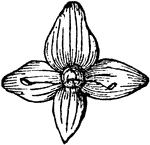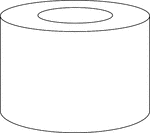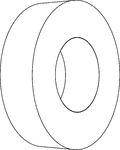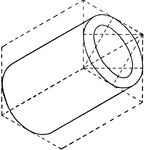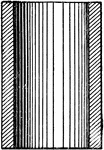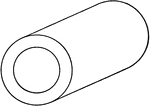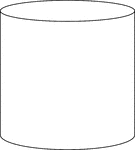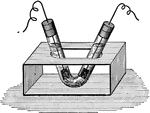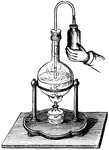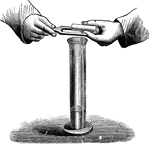
Air Passage
"To illustrate roughly the passage of air through the glottis, force air through such a tube by blowing…

Air-Pump
"The general scheme of Geisler's pump is shown here. A and B are pear-shaped glass vessels connected…
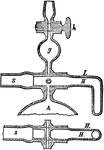
Air-Pump
"The general scheme of Geisler's pump is shown here. A and B are pear-shaped glass vessels connected…

Air-Pump
"This was invented in 1865 by H. Sprengel. The instrument, in its original (simplest) form, consists…
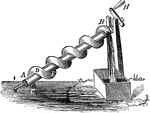
Archimedes' Screw
"Invented to raise water. A hollow tube wound spirally around a solid cylinder. As the cylinder is turned,…
Atmospheric Pressure
"The pressure of the atmosphere may be easily shown by the tube and piston. suppose there is an orifice…
Barometer
"A Torricellian tube, firmly fixed to an upright support and properly graduated, constitutes a mercurial…
Barometer
"A cistern barometer, being that generally seen in weather-glasses or ordinary barometers. The tube…
Barometer
"Suppose a to be a long tube, with the piston b so nicely fitted to its inside, as to work air tight.…

Bulb Hygrometer
"This hygrometer consists of two thermometers a and b similar to each other in all respects except that…

Bunsen's Calorimeter
"In Bunsen's instrument a test tube is sealed into and enclosed by an outer tube, the lower part of…

Centrifugal Mill
"The upright cyclinder a, is a tube which has a funnel shaped mouth for the admission of the stream…

Chain-Pump
"The chain-pump consists of a tube or cylinder, the lower part of which is immersed in a well or reservoir,…
Compressed Air Manometer
"The compressed air manometer consists of a strong graduated glass tube of uniform narrow bore, closed…

Compression Experiment
"If the strong tube, or barrel, be smooth, and equal on the inside, and there be fitted to it the solid…

Cylinder
A cylinder is a body of uniform diameter throughout its entire length, whose ends are equal parallel…
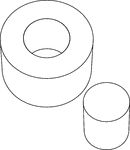
Cylinder Cut From a Cylinder
Illustration of a right circular cylinder with a smaller cylinder removed from the center and placed…
Hollow Cylinder
Illustration of a thin hollow cylinder. It resembles a washer and is often referred to as a disc.
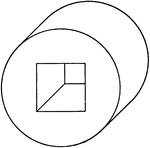
Oblique View Of Hollow Cylinder
Illustration of an oblique view of a hollow cylinder. The portion removed from the center of the cylinder…
Right Circular Cylinder
Illustration of a right circular cylinder with the height larger than the diameter.

2 Right Circular Cylinders
Illustration of 2 right circular cylinders in which one cylinder is twice the height of the other.
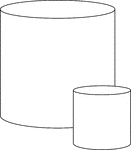
2 Right Circular Cylinders
Illustration of 2 right circular cylinders in which one cylinder is twice the height and twice the diameter…

3 Congruent Tangent Right Circular Cylinders
Illustration of 3 right congruent tangent circular cylinders. The height of all the cylinders is greater…
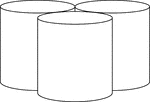
3 Congruent Tangent Right Circular Cylinders
Illustration of 3 right congruent tangent circular cylinders.
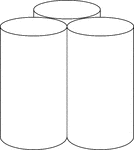
3 Congruent Tangent Right Circular Cylinders
Illustration of 3 right congruent tangent circular cylinders. The height of all the cylinders is greater…

4 Congruent Tangent Right Circular Cylinders
Illustration of 4 congruent tangent right circular cylinders. The height of all the cylinders is greater…
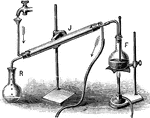
Distilation
"Partly fill with strong brine a Florence glask the cork of which carries a delivery-tube and a thermometer.…
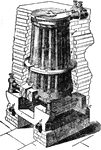
Duplex Tubular Boiler
"The Duplex is made in two equal parts, each being capable of being worked alone. Each section consists…
Kinnersley electrical air-thermometer
"Various methods have been devised for measuring electrostatic quantity, one of the simplest of which…
Two Objects Falling in a Vacuum
"Remove the air from a high glass tube by means of an instrument called the air-pump... Then... drop…

Forcing-Pump
"In the forcing-pump atmospheric pressure plays but a small part. There is no valve in the piston c,…

Hand-Gun
"The hand-gun was used by both infantry and cavalry; it consisted of a simple iron or brass tube with…

Heliometer
"The type of instrument which resulted from Russian labors. The brass tube, strengthened at the bearing…

Hero's Fountain
"It consists of a brass dish A and two glass globes B and C. The dish communicates with the lower part…

Hydraulic Bellows
"An instrument called the hydrostatic bellows, also shows, in a striking manner, the great force of…

Lapidary's Dial
"Lapidary's Dial. A, section; B, side elevation; a, a, jaws; b, ball; c, tube; d, dial; e, cement rod;…

Leslies Hygrometer
"Leslie's hygrometer, which is an adaptation of his differential thermometer, is formed by uniting two…

Lobule of a Lung
"Showing the structure of a lobule of the lung. The lobule has been injected with mercury, afterwards…

Magic Lantern
"Let a candle c, be placed on the inside of a box or tube, so that its light may pass through the plano-convex…

Mecury Barometer
Illustration of a tube inverted over mercury, with the mercury rising inside the test tube 114 millimeters…

Micrometer
"The horizontal section in the direction of the axis of the telescope. The eye-piece ab consists of…

Micrometer
"The vertical section in the direction of the axis of the telescope. The eye-piece ab consists of two…
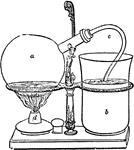
Napier's Coffee Apparatus
"This coffee apparatus consists of a glass globe a, an infusing jar b, of glass or porcelain and a bent…

Tobacco Pipe
A device for smoking, consisting of a tube of wood, clay, or other material with a small bowl at one…
